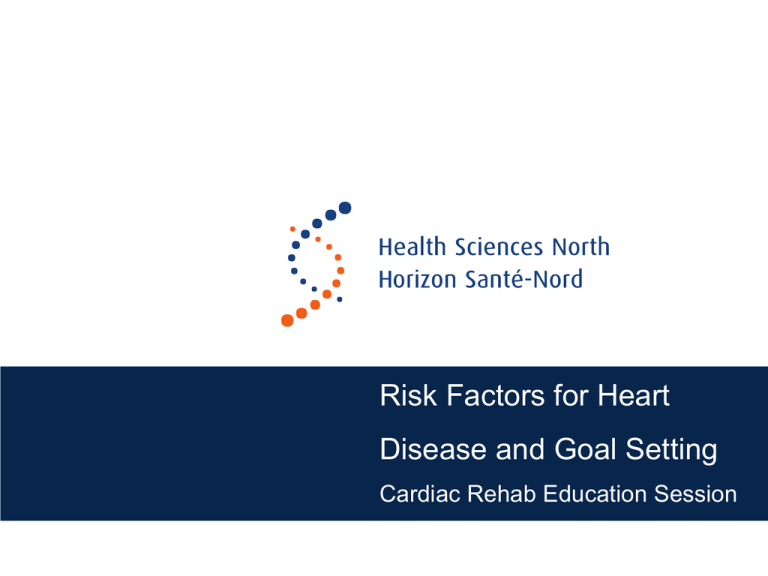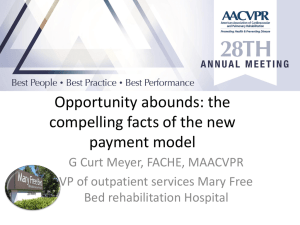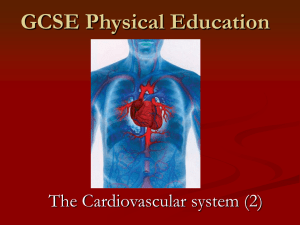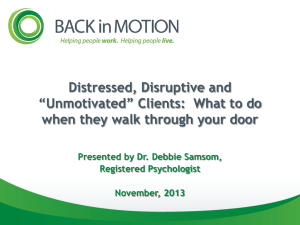Goal Setting Resources at Cardiac Rehab
advertisement

Risk Factors for Heart Disease and Goal Setting Cardiac Rehab Education Session Overview of Session • Identify risk factors for heart disease • Understand some of the ways that you can control or change your risk factors • Learn the importance of goal setting and how to set goals • Learn about the resources at Cardiac Rehab to help you set and achieve your goals Risk Factors in Heart Disease • Risk factors you cannot change • Risk factors you can control • Risk factors you can change Risk Factors You Cannot Change • Family History • Age • Gender • Ethnic Background Risk Factors You Can Control • Blood Pressure • Cholesterol • Diabetes Risk Factors You Can Change • • • • • • Smoking Physical Inactivity Overweight Stress Caffeine Alcohol What is Your Risk? Risk Factors You Can Control • Blood Pressure – Systolic or top number should be <140 – Diastolic or bottom number should be <90 – People with diabetes - should be <130/80 – People’s pressures could be lower due to medications – what’s important is that your doctor is happy with your numbers and you feel well Risk Factors You Can Control • Blood Pressure – Causes irreversible damage to the blood vessels, heart, brain, kidneys, eyes – Caused by several factors including stress, high salt diet, smoking, physical inactivity and inherited factors – Because there are often no symptoms, known as the Silent Killer Risk Factors You Can Control • Blood Pressure – What You Can Do – Limit salt intake – DASH diet (Dietary Approaches to Stop Hypertension) – Increase regular exercise – Stop smoking, avoid second hand smoke – Manage weight – Manage stress – Limit caffeine and alcohol Risk Factors You Can Control • Overall cholesterol value should be less than 4.0 • HDL is your good cholesterol • It helps decrease your bad cholesterol • This value should be greater than 1.0 Risk Factors You Can Control – LDL is your bad cholesterol – It contributes to build up of plaque in your arteries – This value should be less than 2.0 Risk Factors You Can Control – Triglycerides are fat made by the body and also come from our food – When you eat too many calories and do not burn them, the body converts them to fat and stores them as triglycerides Risk Factors You Can Control • Cholesterol – What Can You Do – Replace saturated and trans fat with omega 3 and unsaturated fats – Decrease intake of high cholesterol foods – Increase intake of fruits and vegetables – Add more soluble fibre to your diet – Maintain regular exercise – Take your medication Risk Factors You Can Control • Diabetes – Having high levels of sugars and insulin in your blood add to the build up of plaque in your arteries Risk Factors You Can Control • Diabetes – What You Can Do – Maintain blood sugars in a healthy range – Follow a diet based on the healthy plate and Canada’s Food Guide – Maintain regular exercise – Maintain a healthy weight – Make appt with our Dietitian Risk Factors You Can Change • • • • • • Smoking Physical Inactivity Weight Stress Alcohol Caffeine Goal Setting • Goal setting is a tool you can use to help you change your risk factors • Goal setting lets you tell us how we can make your time here more meaningful for you! Goal Setting • What do you want to be doing six months from now? • What do you want to look like? • How do you want to feel? • What activities do you want to return to or what new activities would you like to try? Why Set Goals? • Goals motivate • Goals help you take control of your rehab process • Goals help the cardiac rehab team to personalize your program • Goals help you measure your progress Types of Goals at Cardiac Rehab • Risk Factors – Lower Blood Pressure – Manage Cholesterol – Manage Diabetes – Quit Smoking – Increase Physical Activity – Lose weight / decrease waist size – Decrease stress / anxiety / depression – Limit caffeine and alcohol intake Types of Goals at Cardiac Rehab • Lifestyle – Play golf again – Work in the garden – Travel – Return to work – Increase energy level – Increase muscle strength – Play with children / grandchildren – Do household tasks Setting SMART Goals • Goals which are set effectively are more likely to be achieved. • One method for setting goals is known as setting SMART goals. SMART stands for: – Specific – Measurable – Achievable – Relevant – Time-based SMART Goals • Specific – – – – What do you want to accomplish? When will this occur? Who is involved? Where are you going to do this? Example: Instead of setting a goal to eat more healthy, set a specific goal to increase intake of fruits and vegetables daily. SMART Goals • Measurable – How will you know you have reached your goal? – Decide on something that can be measured or tracked • Number of servings of fruit per meal • Portion size • Food records Example: Set a goal to eat one fruit or vegetable per meal. SMART Goals • Achievable – Is this a goal I can reach? – Am I likely to be able to do what it takes to reach my goal? – How confident am I that I can achieve this goal? • Scale of 1 – 10 ≤ 7 Rethink goal Example: The goal to become a vegetarian may not be achievable but the goal to incorporate meatless meals once a week is. SMART Goals • Relevant – Is this my goal? – Is this goal meaningful to me? – How important is it for me to achieve this goal? • Scale 1 – 10 ≤ 7 Rethink goal Example: Setting a goal to eat fruits and vegetables because the dietitian told you to is not likely going to work. If you choose to eat them to live longer or to have more energy, you may be more likely to do it! SMART Goals • Time-based – How long will it take me to achieve this goal? – Do I need to break a longer term goal into shorter term goals? Example: I will be eating 7 to 10 servings of fruits and vegetables a day within 6 weeks. I will start by having one fruit or vegetable with every meal. Things to Think About • What are potential problems that could get in the way of me reaching my goal? Examples: taste, cost, having to prepare it, shopping etc… • How will I deal with these problems? Examples: I’ll buy seasonal fruits and vegetables or buy frozen fruits and vegetables to reduce cost and preparation time Goal Setting Resources at Cardiac Rehab • Your case manager You can request a meeting with your case manager to discuss your goals They will be meeting with you at the end of the Recovery Program and will ask you about your goals Angelique Donna Gilles Liisa Paul Trevor Goal Setting Resources at Cardiac Rehab • You can meet with the Nurse Practitioner, the Dietitian, the Psychological Associate or the Kinesiologist • You can make an appointment with these staff through Patti our secretary, through your case manager or by contacting the staff directly Goal Setting Resources at Cardiac Rehab • The Nurse Practitioner can help you set goals with: – Stopping smoking – Lowering your blood pressure – Managing your cholesterol Cindy Goal Setting Resources at Cardiac Rehab • Paul can also help you stop smoking Goal Setting Resources at Cardiac Rehab • The Dietitian can help you set goals with: – Decreasing your salt intake – Managing your cholesterol – Managing your weight Mary Goal Setting Resources at Cardiac Rehab • The Psychological Associate can help you set goals with: – Reducing your stress – Enhancing your stress management skills – Decreasing your anxiety – Improving your mood – Managing your anger Kerry Goal Setting Resources at Cardiac Rehab • The Kinesiologist can help you set goals with: – Returning to work Trevor Goal Setting Resources at Cardiac Rehab • If you have any physical limitations that prevent you from achieving your goal you can ask your case manager to refer you to the Physiotherapist Gilles Set Your Goal! 1. Make a list of things you would like to achieve in the next six months 2. Pick one or two things to work on 3. Use the SMART method for setting your goal 4. List some potential obstacles and ways you will deal with them 5. Make appointments with Cardiac Rehab staff as needed to help you set and achieve your goal Our Goals










